Solitaire is not solitaire as in “I am alone”, it is simply my next town in the Namib desert. But yes, indeed, it’s a remote lonely town. I tried to reach it yesterday, but ended up thirty kilometers short, at Barchan dune, with the very hospitable Willem, who made me forget that I really wanted this famous Solitaire apple pie. Solitaire is then my first stop of this new day.
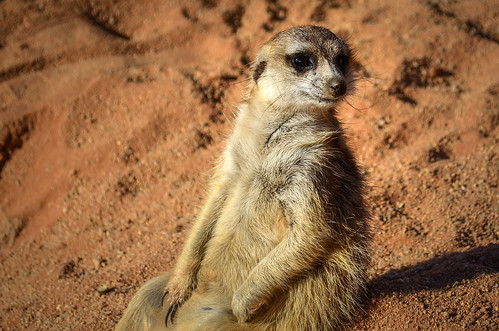
Ideally isolated in a fantastic valley, the farm also has a pet meerkat, living right by the house, who grunts back at the dog trying to sniff him. After the pet warthog, I add the meerkat to my list of unusual pet animals, and it won’t be the last one.


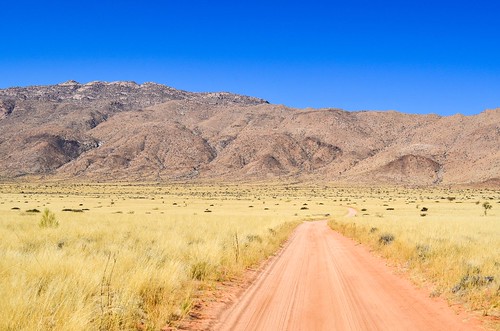
A long talk with Yannick pushes my departure to almost 12, and I jump into the fairly bearable heat under the usual perfect blue sky. The landscape is stunning as usual, and now that I’m done for good with the roller-coaster roads of the Khomas highlands, it’s a very nice smooth ride until Solitaire, and then Sesriem.
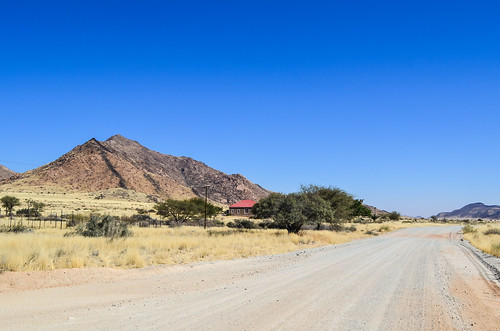

Now down to about 500 m of elevation, the annoying flies make their come-back. The same that used to enter my nostrils and eyes in the Sahara, they are all over me again. This is something that someone travelling by car will probably never realize, that the largest disturbance is this ocean of peace and silence is actually made up of tiny dots with wings. They are that annoying that I end up digging up my faded blue cheche from Morocco to cover my face.

I already tasted three flies within 5 mintes of cycling, so at least with the cheche over my face, I can open my mouth to breathe safely.
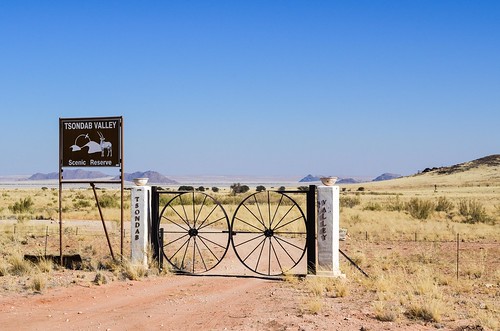
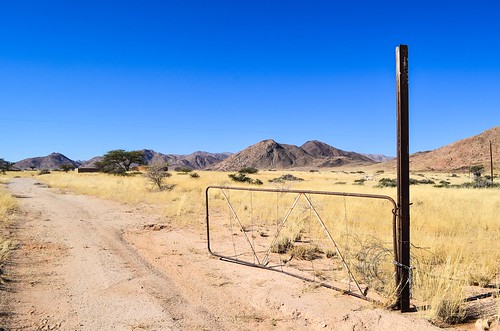


Halfway through the 30 km to Solitaire, I join a bigger road, the one linking Walvis Bay to Sossusvlei, which is on the tourist’s itinerary of even tourists who have no time and try to visit Namibia driving 5000 km in a week. The traffic thus “drastically” increases, with a car every 10 minutes or so.
I have been thinking about Solitaire’s apfelstrudel for four days, since I left Windhoek. Solitaire is the first shop I am meeting on this C26, and the apple strudel of Solitaire’s bakery (wait, a bakery in the desert?) is said to be the best in the world. There is nothing better than food to motivate me, so I am very happy to finally reach it.

I had the presentiment that it would be too touristy for me. Willem had told me that every tourist in Namibia stops in Solitaire and buys an apple strudel, so I lowered my expectations not to be disappointed. It’s full of people who didn’t lose a single sweat drop to get there, and who rush to eat what is planned on their schedule. It’s a very photogenic location indeed, but I don’t feel right here. The road and landscape are as beautiful anywhere else in the area, so I have no reason to sit between 4x4s in a hurry. The apfelstrudel is delicious indeed, but had it been 100 km out of my way, I wouldn’t have minded skipping it. The bakery ladies don’t smile, and they don’t even think that I deserve a bigger portion (NB: this is very wrong, everyone knows I need to eat a huge amount of whatever edible stuff I lay my eyes on).
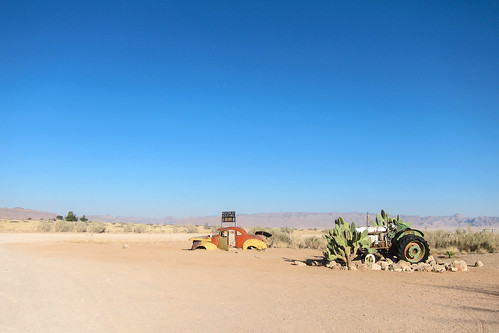
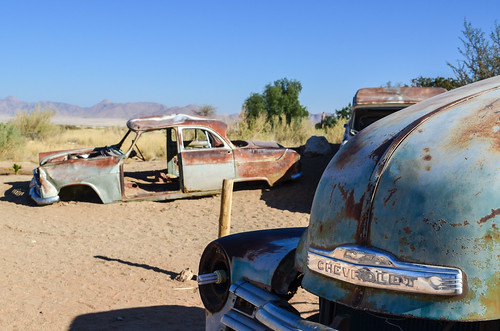

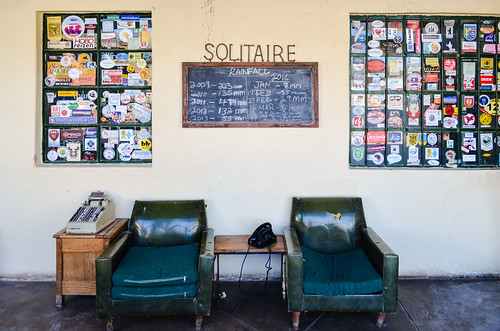
Every window of the shop in Solitaire is covered by overlanders’ stickers. I used to see a few of them when I passed border posts or when I stayed in a popular guesthouse of a large city in West Africa, but the amount there exceeds all I have seen. It is logical in away: most of “Africa overlanders” drive the continent down from the eastern side (the easy side). Once they get south of DRC, they turn west, visit the Victoria falls, and reach South Africa via Namibia (which is also easier to travel than Zimbabwe and Mozambique).
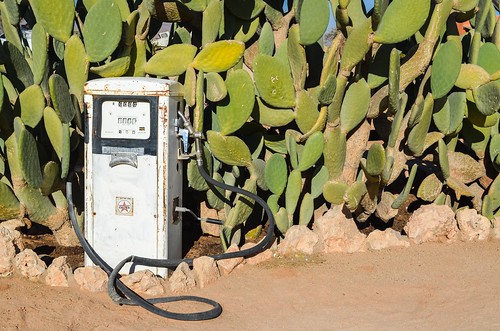
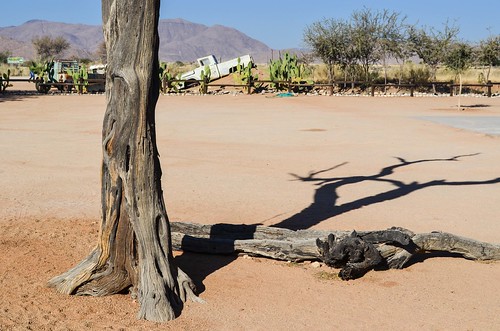
There is quite a lot of French speakers here. Despite the increase in tourism, I was told the Solitaire owner has not made any change to its shop, which indeed looks more like a “general dealer of a tiny village” than a shop that properly addresses the needs of people who didn’t plan smartly the logistics of their 4×4 outing in the desert. But fortunately, Sesriem is much better for that. I just buy bread, fill up my water bottles, and head for more beautiful roads. Probably because 4×4 get to their accommodation much before night (it’s truly too easy to hit a springbok or a warthog on these roads), the last hour of daylight is not only the most beautiful, but also very quiet.
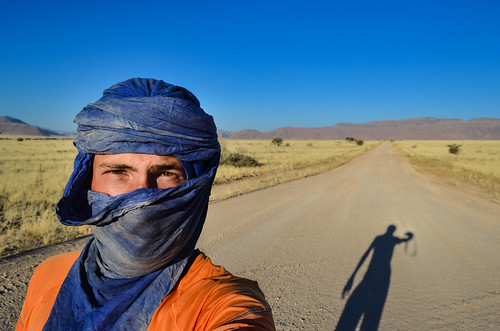
A few kilometers further, there is a non-fenced area on my left. It’s too good to be true, since all the farms are carefully fenced and it requires luck to find a hidden and easily accessible camp spot. It’s almost night, so I hide my tent between large boulders leaning on a hill. After clearing up the grass, it looks like another perfect camp spot.
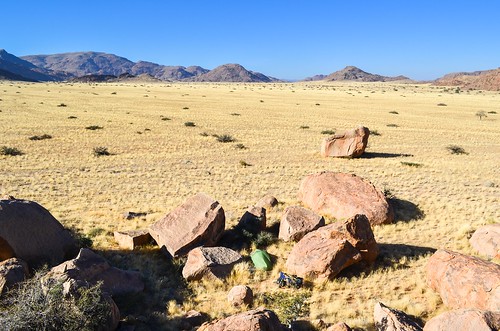
I can easily climb onto the boulders and have a look around. We can fairly assume that I am “in middle of nowhere”, and that I have nothing to fear but small and curious animals. No land in Namibia, or anywhere else, is truly abandoned, so I would expect to be alone but only within, let’s say, a 5 km radius. At night, on my boulder, and with no wind at all, it’s actually easy to become aware of who shares this piece of desert with me.
Surprisingly, there are lights as close as 2 km ahead (at the other end of the cleared farmland on the photo above). It must be the next official campsite, which I thought to be located much further. I have a tourist paper map, which shows the guest farms of the area roughly positioned (the public roads are so few that it doesn’t matter where a farm is located, you just have to make sure you don’t miss the one sign post), and I combine this information with my GPS to guess what is where. The very dim lights on my right must be from a guest farm about 10 km away.
As I lay down on the rock, I heard absolutely nothing. Nothing? No, my heartbeat is actually triggering small moves in my jacket, and I can hear that. When there is so little background noise that I hear my own heartbeat, I can safely say that the place is quiet!
And few times during my listening of the Namib silence, I do hear voices. Two individuals talking together, at a normal voice level with words I can’t decipher. How far could they be? About 2 km away if they are at the “supposed” campsite with lights. Or at least a kilometer away if they are people hidden in that koppie in between. They probably have no reason to be there, but I have even fewer reasons to be where I am. That’s why, even if I have the perfect remote camp spot, I am still reluctant to make noise and use my stove ostentatiously.
The morning is perfect for pictures, and the day can only start well when I wake up after a good 12-hour comfy and silent night.

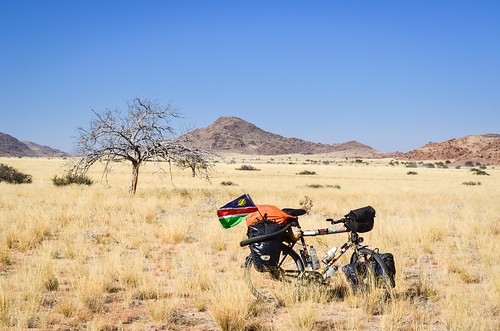

My objective of the day is Sesriem, which should be reached easily on a smooth and flat gravel road. It won’t be that peaceful, since the traffic is horrible – obviously by the standard of a Namibian gravel road: a car every 3 or 5 minutes. It also means the road doesn’t stand well against these 4×4 driving in packs, and becomes destroyed and too corrugated – here again, for Namibian standards.

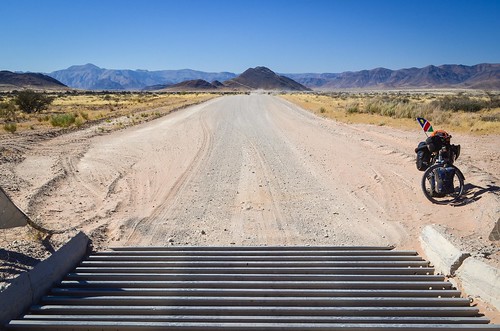
With that traffic, and within the boundaries of a national park, the wild animals are not shy at all. If they were on a farmland, these oryx and springboks would become the property of the farmer, if he shoots them before they jump into another farm, and then probably become biltong (yum!). But here, they just watch me cycling on the gravel road.
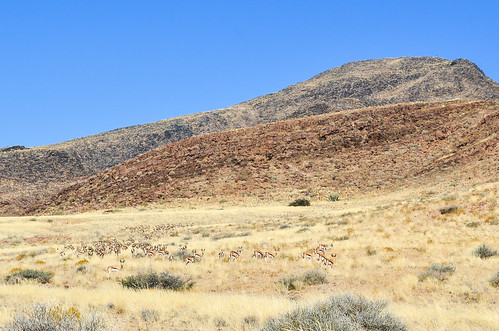
The herd of springboks is not too bothered by me walking to them. My single lens is a 18-55 mm, so I have to, anyway. And no one else is watching, so I decide to run after them until they pronk away. You can’t do that in Etosha or Kruger, which is sad, since running after a hundred springboks is quite fun.
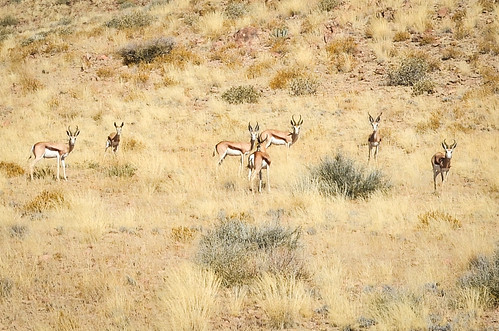


A coca-cola break at one of the many lodges with pool and TV in the middle of nowhere, and I continue my journey in this fantastic scenery. It’s just so beautiful everywhere.


The road improves after 20 km, but there are still many cars. They lift up the gravel dust every time they pass, and it’s all in my eyes. It’s actually quite dangerous for me to be in a dust cloud on the road. Since the 4×4 are often travelling in groups of 2 or 3, if they are driving within close proximity of each other, the followers have little visibility.
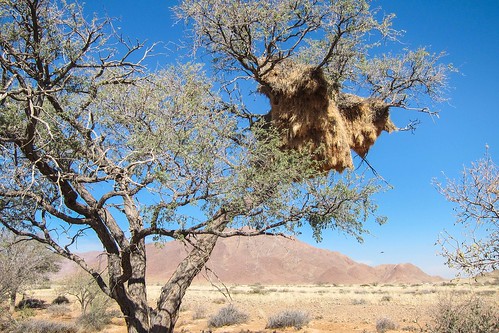
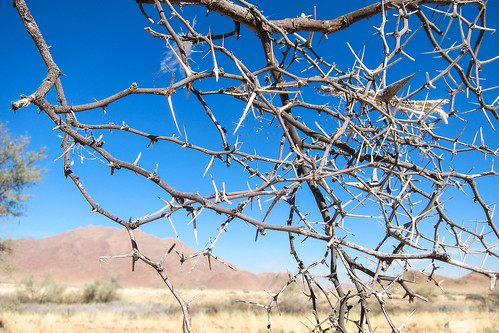
Most of the visitors are driving Windhoek-Sossusvlei and Sossusvlei-Swakopmund in a day, which is a pity: the beauty is not exactly in a lodge in Sesriem, and definitely not in Windhoek or Swakopmund, but in every kilometer of that road. Every kilometer of that C19 to Sesriem is amazing, and I feel that I had a wonderful day with just 60 km of these views.
I see more oryx in the middle of the road, several springbok herds, and brainless ostriches running in the savanna.

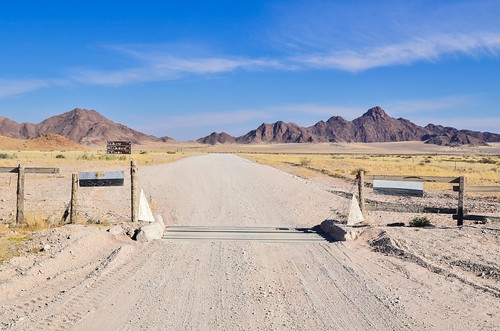

There, I can’t help ranting once more about this highly inaccurate Lonely Planet Africa guide. I don’t follow it, but since I have downloaded PDF versions onto my phone, I check now and then the history of places and the trivia facts. In the Getting around section, I quote the Bicycle paragraph:
Namibia is a desert country and is totally unsuitable for a biking holiday. Distances are great and horizons are vast; the climate and landscapes are hot and very dry; and, even along major routes, water is scarce and villages are widely spread. What’s more, the sun is intense and prolonged exposure to the burning ultraviolet rays is hazardous.
I would rephrase it into:
Namibia is a desert country and is completely recommended for a biking holiday. Distances are great and horizons are vast; the climate and landscapes are hot and very dry; and, even along major routes, water is scarce and villages are widely spread. What’s more, the sun is intense and prolonged exposure to the burning ultraviolet rays is hazardous. But it doesn’t matter at all because you will happily overlook this inconvenience, blinded by the wonderful landscape.


The last stretch of gravel road to Sesriem is quite loose, unpleasant, and the dust is very annoying whenever a car passes. If there is enough wind, it’s easy to deal with it: I just ride on the upwind side of the road, even if it leads some motorists to honk at the cyclist on the wrong side of the road. If there is not enough wind, then I can only look away and stop breathing for a while.

Sesriem is more than just a petrol station along the road, it is the gate to the Sossusvlei dunes. The highest dunes in the world are found some 60 km into the desert, but the road is a dead-end, and the whole length is protected and no one can be there after sunset and before sunrise.
The petrol station has nice foods (for a desert station), a campsite and even an internet café! The campsite is full, but the manager lets me camp for free a bit away from the paying clients, and still access the showers.
The other solution would be camping at the second campsite, the NWR one, which is just across the restricted area, inside. The trick is that people staying at that campsite can drive to the dunes a few minutes earlier than the sunrise, thus allowing them to enjoy the first minutes of the day without visitors who didn’t sleep at the NWR. Since NWR is known for its high rates and poor service, I’d rather avoid it.
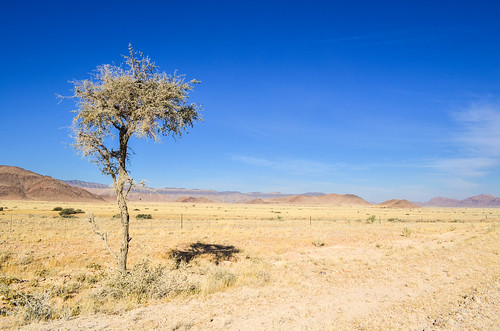
I spend the evening invited for dinner by a group of Dutch, while jackals observe us from close (like 5-10 meters, between the showers and my tent), hoping they could steal some food from us. I check twice that I am not leaving anything open before I fall asleep …
I will be visiting the Sossusvlei dunes the next day. Because it is an exceptional location, the dunes deserve their own blog post …





